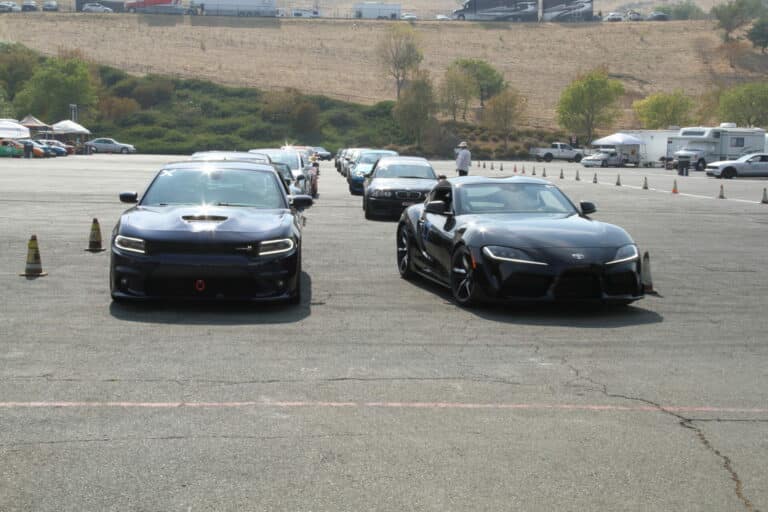
After much prodding from my friends I finally committed to going to my first NASA High Performance Driving Experience at Thunderhill. Not only was this my first HPDE, it also was my first time ever on a road course. I’ve been to a couple autocrosses, but that’s it. Other than that, I’ve had no real racing experience. So, this being my first time, I was really nervous.
To prepare for the track, I went to several websites and message boards and asked others for their experiences and what they did to prepare. Basically, for the car, I was told to change the oil, make sure the brakes had at least 50 percent of the pads left, bleed the brakes and clutch, check all fluid levels and anything else that could potentially be a problem later at the track. So I also lubed my sway bar bushings, double-checked bolts and nuts and stuff like that. Also get the correct Snell rated helmet allowed for the track. It is best to do this stuff a few days prior to the event so you are not rushing around the night before getting things ready.
For myself, again, I used the ‘net to find out how to prepare myself for the track. At the top of the list was: “Have lots of fun!” But stay within your means. Don’t go overboard on your first time out. I had the urge to go fast, but I didn’t know the track, and I didn’t want to wreck my car! Plus I’d end up on the wrong lines to take the correct apex. (Bad thing!) Just take your time and go at your own pace. Remember that you are still learning, so you have to take it one step at a time. Speed will come later when you learn how to drive. Believe me, there are so many things to be aware of on the track that speed will take a backseat! Don’t forget to get a good night’s rest the night before. I made the mistake of getting only three and a half hours of sleep the night before, and I missed one session because I fell asleep waiting for the next run. Oops! Better to fall asleep in the pits than in your car!
Once at the track, be prepared for sensory overload. Throw out everything you think you know from driving on the streets, and open up your brain to learn how to race for real. Since I was new, I was in HPDE1, so an instructor is required. You will meet up with him/her before you head out on track. Before my run group I got to ride with my instructor in his Pro 7 RX-7 racecar. To be honest with you, I was getting motion sickness from, I’m assuming, all the g-forces going around the track. But it gave me a chance to see the layout of the course before going out myself, which was also invaluable to learning the track. It also gave me a chance to see what a real racecar can do. Lots of fun, even after getting sick!
While on the track, you need to be aware of so many things all at once. I found this hard to do! You need to be aware of all the cars around you, what lines to take, the apexes, flag stations, color of the flags, shifting, steering, braking, throttle, etc., just to name a few! Looking far ahead is also very important! That way you can see where you need to set yourself up to hit the right racing line and apex — or, if you need to avoid an accident ahead of you or watch for flags. But don’t be intimidated by this. Remember that everyone on the track has gone through the same thing you and I are. It’s a learned skill, and you will get better as the day goes on. I’ll be the first one to tell you that I still don’t have that down. But as my instructors told me, that stuff will become second nature with more track time.
After each run, it is also good to go over with your instructor how you think the run was. From there, your instructor can critique your driving and tell you where you need to improve. This is very helpful since the instructors know the track inside and out. If you really want to get better, you’ll listen to them.
At day’s end, you will have bettered yourself as a driver both on a course and on the streets. A lot of what you learned can be taken back to everyday driving, like looking far ahead and being aware of your surroundings! You will also have an idea of just what your car can do when pushed to the limits. In other words, you will learn just what your car was made of and where you may need to improve the car to handle the track and street better. Although I can’t go all the time, I am definitely going to go again! It was just so much fun! Autocrossing was fun, too, but there is nothing like driving on a real road course and learning about you as a driver! Consider me addicted!
By Gary Lee
What is weight transfer? A car, at rest, distributes its weight over...
Some people believe that an occasional spin or crash is essential to...
Many drivers believe that the key to driving quickly is to drive...
UpshiftingUpshifting should be done smoothly. Speedshifting will shorten the gearbox life. The...
The line is the path around the track, that when driven at...
Learn the essential rules of passing during HPDE events to ensure safety...
Whether your goal is to run HPDE or to be the next...
Now that you have signed up for the HPDE, you need to...